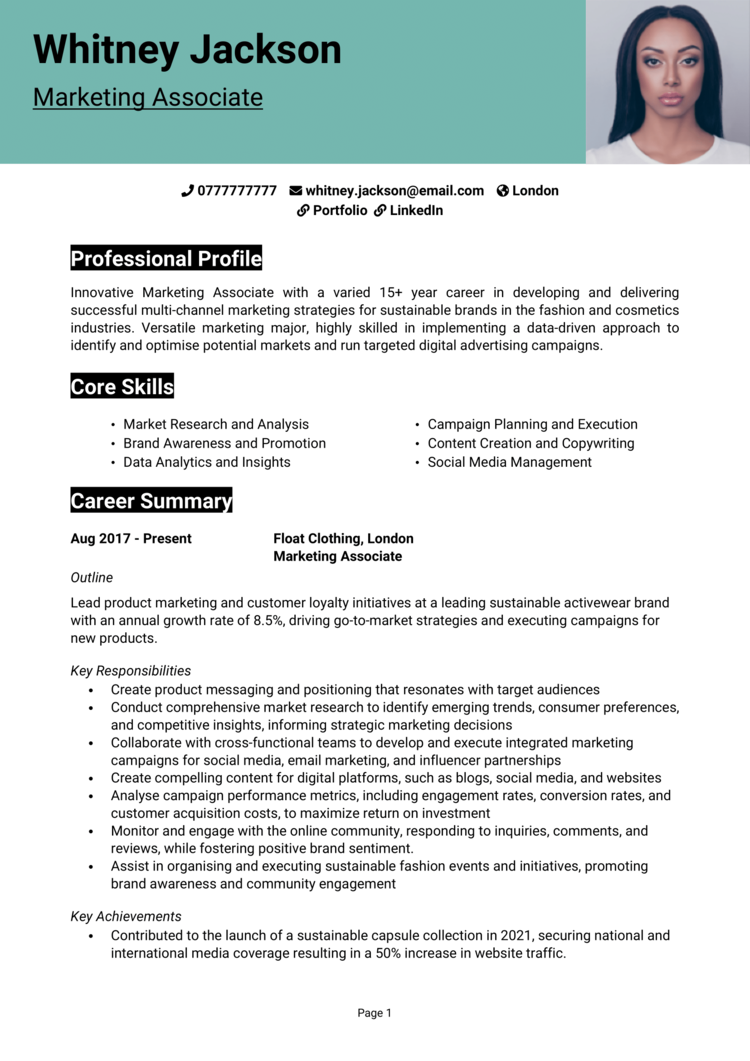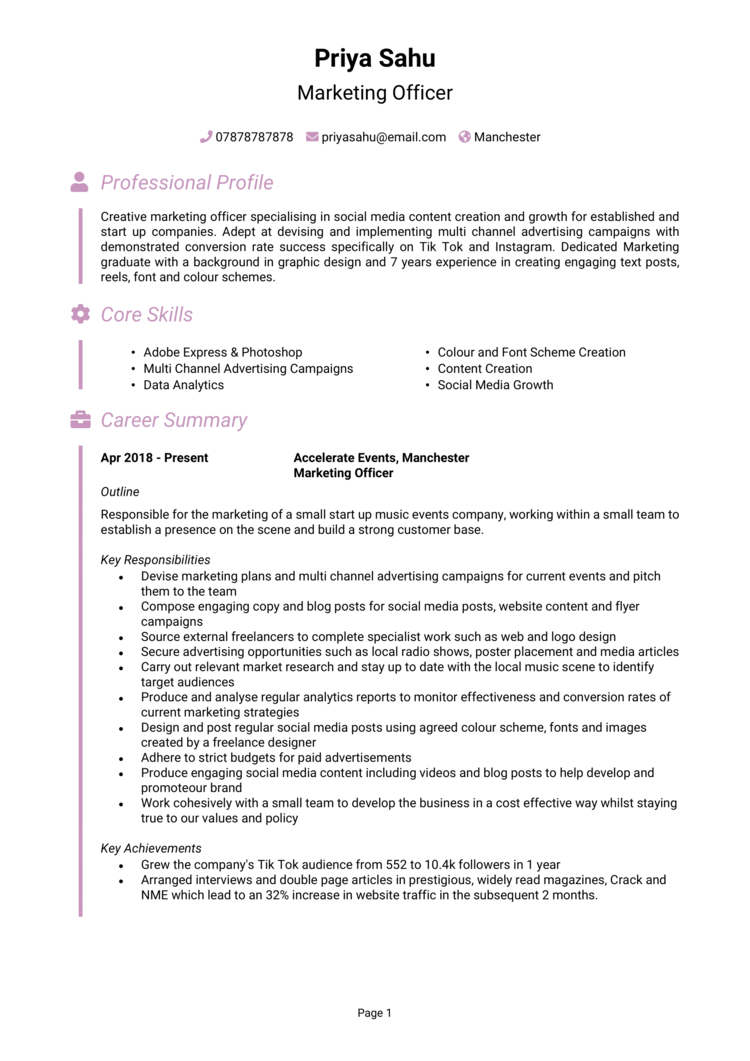You know how to capture an audience’s attention – all you’ve got to do first is make sure your CV gets the same engagement.
Your CV needs to market you. Employers want to see creativity, strong organisational skills, and your ability to analyse data to see what’s working (and what’s not).
This step-by-step guide and its 4 Marketing Assistant CV examples will help you stand out amongst the competition and land a new role in marketing.
Marketing Assistant CV

Marketing Analyst CV

Marketing Associate CV

Marketing Officer CV

How to write your Marketing Assistant CV
Discover how to craft a Marketing Assistant CV that lands interviews with this simple step-by-step guide.
This guide will take you step by step through building a strong CV, helping you showcase everything from your digital skills to your ability to manage campaigns and analyse performance. By the end, you’ll be writing a CV that’s just as engaging as your best campaign.
The best way to structure your Marketing Assistant CV


Think of your CV like a marketing funnel – clear steps that guide the reader through your strengths, skills, and achievements. A clear CV structure helps hiring managers spot your creativity and campaign experience without digging for details.
Here’s the layout for your CV to follow:
- Name and contact details – Display your personal details clearly at the top so employers can get in touch easily. Including a photo is entirely optional.
- Profile – Begin with a snapshot highlighting your marketing knowledge, creative skills, and administrative abilities.
- Core skills – Bullet point your most valuable abilities, such as content creation, campaign coordination, and analytics.
- Work experience – Outline past marketing roles, internships, or placements, focusing on practical experience and technical know-how.
- Education – Include your relevant degrees, diplomas, or training in marketing or communications.
- Additional info – Optionally mention hobbies, industry memberships, or marketing awards.
How should you format a Marketing Assistant CV?


An unreadable CV full of mistakes is the professional equivalent of Comic Sans on a flyer – for everyone’s sake, please just don’t. Presentation matters in marketing, and your CV is no exception. If the format makes it hard to read, no one will stick around to discover your talents.
Use these tips to keep your format clean and professional:
- Bullet points – Use these to break down key information so it’s easy to skim.
- Divide sections – Clearly label each part to guide the reader through your experience.
- Use a clear and readable font – Use a simple, professional font and keep your layout uncluttered for maximum readability.
- No more than 2 pages – This is enough length to highlight your expertise while keeping the recruiter interested.
The best way to write a Marketing Assistant CV profile


Your CV profile is where you prove you know how to promote a brand – starting with your own. It quickly introduces you to potential employers, giving them a snapshot of your skills and ambitions.
As a Marketing Assistant, you want to highlight your creativity, organisational skills, and understanding of key marketing processes, with the ultimate aim of convincing a recruiter that hiring you would benefit them.
Marketing Assistant CV profile examples
Profile 1
Creative and detail-oriented Marketing Assistant with three years of experience supporting digital and traditional marketing campaigns. Skilled in social media management, content creation, and market research. Proficient in Adobe Creative Suite, Google Analytics, and email marketing platforms. Passionate about brand storytelling and customer engagement.
Profile 2
Organised Marketing Assistant with two years of expertise in campaign coordination, data analysis, and promotional content creation. Adept at managing social media channels, optimising SEO strategies, and supporting product launches. Experienced in working with CRM and marketing automation tools. Committed to driving brand awareness and supporting marketing initiatives.
Profile 3
Results-driven Marketing Assistant with over four years of experience in content marketing, event planning, and digital advertising. Skilled in conducting market research, managing influencer collaborations, and tracking campaign performance. Proficient in social media scheduling tools, copywriting, and data reporting. Dedicated to enhancing brand reach and improving marketing efficiency.
Details to put in your Marketing Assistant CV profile
Here’s what to include:
- Marketing knowledge – Mention your understanding of marketing channels and strategies.
- Creative and content skills – Highlight experience in writing, content creation, or design if relevant.
- Campaign support – Show you can handle the day-to-day admin that keeps campaigns moving.
- Analytical abilities – Mention experience with campaign analysis and data reporting.
- Team collaboration – Emphasise your ability to work with designers, copywriters, and external partners.
How to present your core skills section properly


Now, time for your SEO section – keywords matter if you want to get found. Your CV skills section should quickly bullet point the technical and creative abilities you bring to the role. For Marketing Assistant jobs, that could include everything from social media scheduling to campaign reporting.
Tailor this section based on the job description – different employers will emphasise different skills. For example, a digital agency might value SEO knowledge, while an in-house role could focus on administrative coordination and event planning.
Key skills that make a Marketing Assistant CV stand out
- Social Media Management – Assisting with content creation, scheduling, and engagement across platforms like Instagram, LinkedIn, and Facebook.
- Market Research and Competitor Analysis – Conducting research on industry trends, customer preferences, and competitor strategies.
- Content Creation and Copywriting – Writing blog posts, social media captions, and marketing materials to attract and engage audiences.
- Email Marketing – Assisting in the creation and management of email campaigns using platforms like Mailchimp or HubSpot.
- SEO and Digital Marketing – Supporting search engine optimisation (SEO) efforts and paid digital advertising campaigns.
- Graphic Design and Branding – Using tools like Canva or Adobe Creative Suite to create visuals for marketing campaigns.
- Event Planning and Coordination – Assisting with promotional events, trade shows, and webinars to enhance brand visibility.
- Marketing Analytics and Reporting – Tracking campaign performance using tools like Google Analytics and social media insights.
- CRM and Marketing Automation – Using platforms like Salesforce or Marketo to manage customer data and automate marketing workflows.
- Administrative Support – Assisting with scheduling, presentations, and coordination of marketing activities.
How to present work experience in your CV


Whether you’ve had a marketing internship, a junior role, or relevant work experience in admin or creative fields, this section should show how you’ve developed your skills in real-world environments.
Focus on tasks where you supported marketing campaigns, managed content, or contributed ideas. Even non-marketing roles can highlight transferable skills like organisation or creative problem-solving, if you’re light on professional marketing experience.
How should you list jobs on your Marketing Assistant CV?

- Outline – Briefly describe the company, its size, and the marketing team you supported.
- Responsibilities – Explain the tasks you handled, such as creating content calendars, coordinating events, or analysing campaign performance. Use action words like “assisted,” “created,” and “monitored.”
- Achievements – Highlight any measurable impact you made, such as improving engagement rates, contributing to a successful campaign launch, or streamlining processes.
Work history examples for Marketing Assistants
Marketing Assistant | Lightspark Digital
Outline
Within the marketing department of a leading UK digital agency, supported multi-channel campaigns, social media management, and content production.
Responsibilities
- Assisted in developing digital marketing campaigns, ensuring alignment with brand objectives.
- Managed social media accounts, creating and scheduling engaging posts to increase brand visibility.
- Conducted market research and competitor analysis to identify industry trends.
- Created email marketing campaigns, tracking open rates and engagement metrics.
- Provided administrative support for marketing events, including logistics coordination.
Achievements
- Increased social media engagement by 40 percent through optimised content strategies.
- Helped improve email open rates by 20 percent with better segmentation and A/B testing.
- Recognised for streamlining marketing workflows, reducing project turnaround time by 30 percent.
Marketing Assistant | Millstone Retailers
Outline
For a national retail chain, assisted in executing marketing initiatives to promote new products and enhance customer engagement.
Responsibilities
- Supported the planning and execution of promotional campaigns, including seasonal product launches.
- Designed marketing materials such as flyers, brochures, and in-store advertisements.
- Monitored website traffic and social media analytics to assess campaign effectiveness.
- Liaised with external agencies to coordinate advertising and PR efforts.
- Assisted in influencer outreach and partnerships to enhance brand awareness.
Achievements
- Boosted website traffic by 25 percent by optimising digital content and SEO.
- Contributed to a campaign that led to a 15 percent increase in in-store footfall.
- Helped implement a loyalty program that improved customer retention by 20 percent.
Marketing Assistant | Electrosolutions
Outline
Within the marketing team of a global technology firm, supported B2B marketing initiatives, content creation, and lead generation efforts.
Responsibilities
- Created blog content, case studies, and social media posts to drive brand engagement.
- Assisted in paid ad campaigns, managing PPC and LinkedIn advertising strategies.
- Developed email marketing campaigns, segmenting audiences for better conversion rates.
- Tracked and analysed marketing data, preparing reports for senior management.
- Collaborated with sales teams to ensure alignment between marketing efforts and lead generation goals.
Achievements
- Increased inbound leads by 30 percent through targeted email campaigns.
- Optimised PPC ads, reducing cost-per-click by 20 percent while improving ROI.
- Recognised for improving content engagement and social media performance.
Presenting your education history


For Marketing Assistant roles, employers will look at both academic qualifications and hands-on experience. If you have a degree or diploma in marketing, communications, or a related field, highlight it here. Keep your education section brief though, because experience is always more valuable to recruiters.
If you’ve completed specialist training – like a digital marketing course or Google Analytics certification – mention that too. Recent graduates can also highlight key modules or dissertation topics if they relate directly to the role.
Best qualifications for a Marketing Assistant
- BA/BSc in Marketing, Communications, or Business – The most relevant academic foundation for this role.
- CIM Foundation Certificate in Marketing – A respected qualification to enhance your credentials.
- Google Analytics Certification – Demonstrates analytical and reporting skills valued in digital marketing roles.
- Social Media Marketing Certification (HubSpot or similar) – Useful if the role involves social management.
- Digital Marketing Course (General Assembly, Reed, or similar) – Shows practical, hands-on training.





